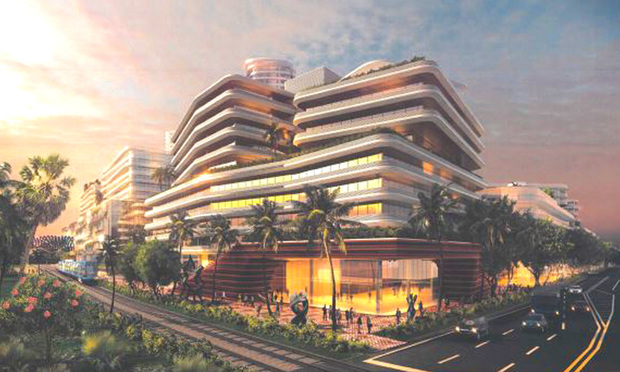 A rendering of the proposed Eastside Ridge project that will span 22.5 acres on the southeast corner of Northeast 54th Street and Second Avenue near Little Haiti. Courtesy rendering
A rendering of the proposed Eastside Ridge project that will span 22.5 acres on the southeast corner of Northeast 54th Street and Second Avenue near Little Haiti. Courtesy rendering
A Miami board wants to evaluate an increasingly controversial development regulation that has allowed large-scale projects despite concerns that neighborhoods are gentrifying and losing their character.
Special area plans, or SAPs, allow developers of nine or more abutting acres to build higher and denser than normally allowed in exchange for community benefits such as affordable housing and parks.
Developers and supporters say the projects are jump-starting the economy in struggling areas, but opponents counter that SAPs are out of sync in neighborhoods outside the urban core and push out low- and middle-income renters.
The mixed-use Brickell City Centre scaled up building heights off Brickell Avenue, which was already dominated by high-rises. Now at the forefront of the SAP debate is low-scale, low-rise Little Haiti.
The city has approved expansion of the Miami Jewish Health Systems' campus and the Magic City Innovation District under SAP plans. The developer of another proposed SAP project, Eastside Ridge, opted to sue the city over repeated Planning, Zoning and Appeals Board vote delays.
Residents in the Little Haiti area "came to that neighborhood when no one else wanted it. Now everyone wants it, and they are saying 'Get the hell out' to the people who live there," board member Anthony Parrish said at the Nov. 20 meeting. "That is not preserving the neighborhood."
On Wednesday, the planning board will delve into SAPs and take public comments. The board will take no definitive vote but might direct staff to write a resolution generated from the discussion.
Recommending a SAP moratorium and policy review to the City Commission is an option. The planning board on Nov. 20 voted down a temporary SAP moratorium pending more discussion and community input.
Adopted in 2009 in a citywide zoning overhaul, the Miami 21 code allowed SAPs and called for neighborhood preservation, but Parrish said SAPs discourage preservation. He maintains they work in dense areas such as Brickell but not in Little Haiti northeast of Interstates 95 and 195.
"No one is able to argue that multiple SAPs aren't going to obliterate Little Haiti," Parrish said.
Board member Adam Gersten drafted discussion points to guide the conversation starting with the thinking behind SAPs and drilling down to the processes for staff analyses, public input and community benefit negotiations.
Parrish added eight questions, including whether the city should separate multiple SAPs in the same area by both space and time.
Board member Alex Dominguez suggested the city should consider hiring an outside consultant to suggest SAP changes, saying city staff members are facing too much political pressure to green-light projects.
"There's no way an urban planner in this city who knows what he is doing would have allowed the type of urban development that we've had in the last 10 years. It's absurd. I've never seen since I have been here something that says, 'This is a bad idea. We recommend denial on the grounds of traffic,' " Dominguez said.
Deputy planning director Jeremy Calleros Gauger countered developers hire their own traffic consultants and the city also hires outsiders to review proposals. Staff reviews whether projects meet established criteria.
Public-interest law firm Community Justice Project Inc., the Family Action Network Movement community organization and others submitted suggested changes.
Among them: When multiple SAPs are planned in the same area, the city should consider their collective impact rather than separate review, and community land trusts should be formed for residents to collectively buy property and give them a stake in the neighborhood.
Eastside Lawsuit
The planning board's SAP undertaking comes as the proposed Eastside Ridge developer sued the city over five voting delays.
Eastside would have 3,157 residential units, 418 hotel rooms, 97,103 square feet of offices, 283,798 square feet of other commercial space and 5,246 parking spaces in 14 buildings on 22 acres southeast of Northeast 54th Street and Second Avenue.
SPV Realty LC is asking the court to compel the advisory board to vote on the project. SPV doesn't need board approval — just a vote — to move on to the City Commission.
This got some members frustrated with the board having no teeth because, as evidenced by Eastside, the commission can override a no vote by the board.
Board Chairman Charles Garavaglia on Nov. 20 questioned how much pull the board's SAP discussion will have.
"I don't know what the city is going to do with that other than, 'The community got an opportunity to express their frustration,' " he said.
Related stories:
Miami Sued by Eastside Ridge Developer After Five Planning Delays
Proposal for Miami's Eastside Ridge Project Delayed — Again
Magic City Innovation District Approved by Miami After Commission Shuts Down Opponents
Miami's Magic City Innovation District Could Displace 3,000+ Little Haiti Households, Study Says
© Touchpoint Markets, All Rights Reserved. Request academic re-use from www.copyright.com. All other uses, submit a request to [email protected]. For more inforrmation visit Asset & Logo Licensing.







